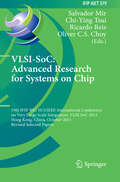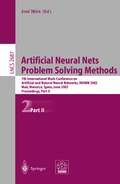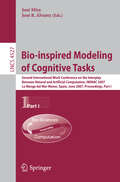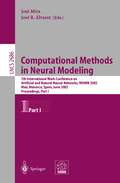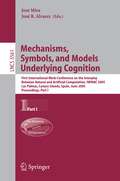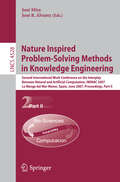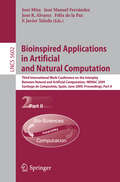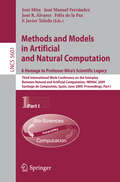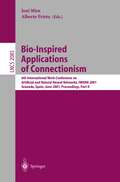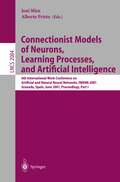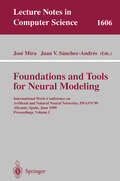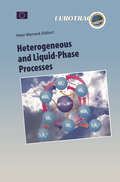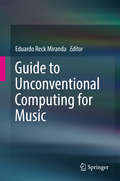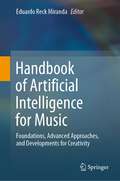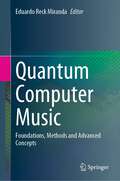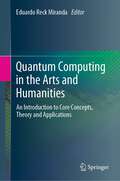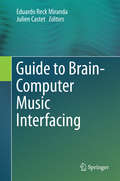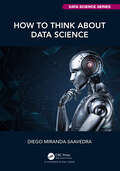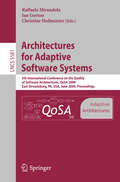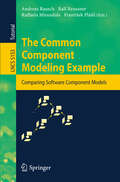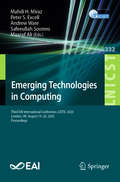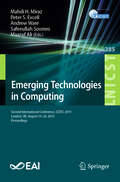- Table View
- List View
VLSI-SoC: 19th IFIP WG 10.5/IEEE International Conference on Very Large Scale Integration, VLSI-SoC 2011, Hong Kong, China, October 3-5, 2011, Revised Selected Papers (IFIP Advances in Information and Communication Technology #379)
by Salvador Mir Chi-Ying Tsui Ricardo Reis Oliver C. S. ChoyThis book contains extended and revised versions of the best papers presented at the 19th IFIP WG 10.5/IEEE International Conference on Very Large Scale Integration, VLSI-SoC 2011, held in Hong Kong, China, in October 2011. The 10 papers included in the book were carefully reviewed and selected from the 45 full papers and 16 special session papers presented at the conference. The papers cover a wide range of topics in VLSI technology and advanced research. They address the current trend toward increasing chip integration and technology process advancements bringing about stimulating new challenges both at the physical and system-design levels, as well as in the test of theses systems.
Artificial Intelligence and Knowledge Engineering Applications: First International Work-Conference on the Interplay Between Natural and Artificial Computation, IWINAC 2005, Las Palmas, Canary Islands, Spain, June 15-18, 2005, Proceedings, Part II (Lecture Notes in Computer Science #3562)
by José Mira José R. ÁlvarezArtificial Neural Nets. Problem Solving Methods: 7th International Work-Conference on Artificial and Natural Neural Networks, IWANN 2003, Maó, Menorca, Spain, June 3-6. Proceedings, Part II (Lecture Notes in Computer Science #2687)
by José Mira José R. AlvarezBio-inspired Modeling of Cognitive Tasks: Second International Work-Conference on the Interplay Between Natural and Artificial Computation, IWINAC 2007, La Manga del Mar Menor, Spain, June 18-21, 2007, Proceedings, Part I (Lecture Notes in Computer Science #4527)
by José Mira José R. ÁlvarezThe first of a two-volume set, this book constitutes the refereed proceedings of the Second International Work-Conference on the Interplay between Natural and Artificial Computation, IWINAC 2007, held in La Manga del Mar Menor, Spain in June 2007. It includes all the contributions mainly related with theoretical, conceptual and methodological aspects linking AI and knowledge engineering with neurophysiology, clinics and cognition.
Computational Methods in Neural Modeling: 7th International Work-Conference on Artificial and Natural Neural Networks, IWANN 2003, Maó, Menorca, Spain, June 3-6. Proceedings, Part I (Lecture Notes in Computer Science #2686)
by José Mira José R. ÁlvarezMechanisms, Symbols, and Models Underlying Cognition: First International Work-Conference on the Interplay Between Natural and Artificial Computation, IWINAC 2005, Las Palmas, Canary Islands, Spain, June 15-18, 2005, Proceedings, Part I (Lecture Notes in Computer Science #3561)
by José Mira José R. ÁlvarezNature Inspired Problem-Solving Methods in Knowledge Engineering: Second International Work-Conference on the Interplay Between Natural and Artificial Computation, IWINAC 2007, La Manga del Mar Menor, Spain, June 18-21, 2007, Proceedings, Part II (Lecture Notes in Computer Science #4528)
by José Mira José R. ÁlvarezThe second of a two-volume set, this book constitutes the refereed proceedings of the Second International Work-Conference on the Interplay between Natural and Artificial Computation, IWINAC 2007, held in La Manga del Mar Menor, Spain in June 2007. It contains all the contributions connected with biologically inspired methods and techniques for solving AI and knowledge engineering problems in different application domains.
Bioinspired Applications in Artificial and Natural Computation: Third International Work-Conference on the Interplay Between Natural and Artificial Computation, IWINAC 2009, Santiago de Compostela, Spain, June 22-26, 2009, Proceedings, Part II (Lecture Notes in Computer Science #5602)
by Jose Mira José M. Ferrández Jose-Ramon Alvarez Sanchez Felix Paz Javier ToledoThe two-volume set LNCS 5601 and LNCS 5602 constitutes the refereed proceedings of the Third International Work-Conference on the Interplay between Natural and Artificial Computation, IWINAC 2009, held in Santiago de Compostela, Spain, in June 2009. The 108 revised papers presented are thematically divided into two volumes. The first volume includes papers relating the most recent collaborations with Professor Mira and contributions mainly related with theoretical, conceptual and methodological aspects linking AI and knowledge engineering with neurophysiology, clinics and cognition. The second volume contains all the contributions connected with biologically inspired methods and techniques for solving AI and knowledge engineering problems in different application domains.
Methods and Models in Artificial and Natural Computation. A Homage to Professor Mira's Scientific Legacy: Third International Work-Conference on the Interplay Between Natural and Artificial Computation, IWINAC 2009, Santiago de Compostela, Spain, June 22-26, 2009, Proceedings, Part I (Lecture Notes in Computer Science #5601)
by Jose Mira José M. Ferrández Jose-Ramon Alvarez Sanchez Felix Paz Javier ToledoThe two-volume set LNCS 5601 and LNCS 5602 constitutes the refereed proceedings of the Third International Work-Conference on the Interplay between Natural and Artificial Computation, IWINAC 2009, held in Santiago de Compostela, Spain, in June 2009. The 108 revised papers presented are thematically divided into two volumes. The first volume includes papers relating the most recent collaborations with Professor Mira and contributions mainly related with theoretical, conceptual and methodological aspects linking AI and knowledge engineering with neurophysiology, clinics and cognition. The second volume contains all the contributions connected with biologically inspired methods and techniques for solving AI and knowledge engineering problems in different application domains.
Bio-Inspired Applications of Connectionism: 6th International Work-Conference on Artificial and Natural Neural Networks, IWANN 2001 Granada, Spain, June 13-15, 2001, Proceedings, Part II (Lecture Notes in Computer Science #2085)
by Jose Mira Alberto PrietoUnderlying most of the IWANN calls for papers is the aim to reassume some of the motivations of the groundwork stages of biocybernetics and the later bionics formulations and to try to reconsider the present value of two basic questions. The?rstoneis:“Whatdoesneurosciencebringintocomputation(thenew bionics)?” That is to say, how can we seek inspiration in biology? Titles such as “computational intelligence”, “arti?cial neural nets”, “genetic algorithms”, “evolutionary hardware”, “evolutive architectures”, “embryonics”, “sensory n- romorphic systems”, and “emotional robotics” are representatives of the present interest in “biological electronics” (bionics). Thesecondquestionis:“Whatcanreturncomputationtoneuroscience(the new neurocybernetics)?” That is to say, how can mathematics, electronics, c- puter science, and arti?cial intelligence help the neurobiologists to improve their experimental data modeling and to move a step forward towards the understa- ing of the nervous system? Relevant here are the general philosophy of the IWANN conferences, the sustained interdisciplinary approach, and the global strategy, again and again to bring together physiologists and computer experts to consider the common and pertinent questions and the shared methods to answer these questions.
Connectionist Models of Neurons, Learning Processes, and Artificial Intelligence: 6th International Work-Conference on Artificial and Natural Neural Networks, IWANN 2001 Granada, Spain, June 13-15, 2001, Proceedings, Part I (Lecture Notes in Computer Science #2084)
by Jose Mira Alberto PrietoUnderlying most of the IWANN calls for papers is the aim to reassume some of the motivations of the groundwork stages of biocybernetics and the later bionics formulations and to try to reconsider the present value of two basic questions. The?rstoneis:“Whatdoesneurosciencebringintocomputation(thenew bionics)?” That is to say, how can we seek inspiration in biology? Titles such as “computational intelligence”, “arti?cial neural nets”, “genetic algorithms”, “evolutionary hardware”, “evolutive architectures”, “embryonics”, “sensory n- romorphic systems”, and “emotional robotics” are representatives of the present interest in “biological electronics” (bionics). Thesecondquestionis:“Whatcanreturncomputationtoneuroscience(the new neurocybernetics)?” That is to say, how can mathematics, electronics, c- puter science, and arti?cial intelligence help the neurobiologists to improve their experimental data modeling and to move a step forward towards the understa- ing of the nervous system? Relevant here are the general philosophy of the IWANN conferences, the sustained interdisciplinary approach, and the global strategy, again and again to bring together physiologists and computer experts to consider the common and pertinent questions and the shared methods to answer these questions.
Foundations and Tools for Neural Modeling: International Work-Conference on Artificial and Natural Neural Networks, IWANN'99, Alicante, Spain, June 2-4, 1999, Proceedings, Volume I (Lecture Notes in Computer Science #1606)
by Jose Mira Juan V. Sanchez-AndresThis book constitutes, together with its compagnion LNCS 1607, the refereed proceedings of the International Work-Conference on Artificial and Natural Neural Networks, IWANN'99, held in Alicante, Spain in June 1999.The 89 revised papers presented were carefully reviewed and selected for inclusion in the book. This volume is devoted to foundational issues of neural computation and tools for neural modeling. The papers are organized in parts on neural modeling: biophysical and structural models; plasticity phenomena: maturing, learning, and memory; and artificial intelligence and cognitive neuroscience.
Heterogeneous and Liquid Phase Processes: Laboratory Studies Related to Aerosols and Clouds (Transport and Chemical Transformation of Pollutants in the Troposphere #2)
by P. Mirabel G. A. Salmon C. Vinckier C. ZetzschThe "European Experiment on the Transport and Transformation of Environmentally Relevant Trace Constituents over Europe" (EUROTRAC) was established in 1986 to tackle the scientific problem and combine the expertise, knowledge and resources in Europe, in order to apply them over a large region covering the greater part of the continent. EUROTRAC is a coordinated multidisciplinary scientific research project involving field measurements, laboratory studies, instrument development and development of comprehensive computer models for the simulation of the physical and chemical processes in the lower atmosphere.
Evolutionary Computer Music
by Eduardo R. Miranda John Al BilesThis book discusses the applications of evolutionary computation to music and the tools needed to create and study such systems. These tools can be combined to create surrogate artificial worlds populated by interacting simulated organisms in which complex musical experiments can be performed. The book demonstrates that evolutionary systems can be used to create and to study musical compositions and cultures in ways that have never before been achieved.
Guide to Unconventional Computing for Music
by Eduardo Reck MirandaThis pioneering text/reference explores how innovative new modes of computation may provide exciting new directions for future developments in the music industry, guiding the reader through the latest research in this emerging, interdisciplinary field. This work includes coverage of electronic music compositions and performances that incorporate unconventional interfacing, hacking and circuit bending. Features: presents an introduction to unconventional computing in music; discusses initiatives involving biophysical electronic music, the work of self-styled silicon luthiers, and the intersection of music and quantum computing; introduces the memristor, a new electronic component with the potential to revolutionize how computers are built; reviews experiments and practical applications of biological memristors in music; describes IMUSIC, an unconventional tone-based programming language, which enables the programming of computers using musical phrases; includes review questions at the end of each chapter.
Handbook of Artificial Intelligence for Music: Foundations, Advanced Approaches, and Developments for Creativity
by Eduardo Reck MirandaThis book presents comprehensive coverage of the latest advances in research into enabling machines to listen to and compose new music. It includes chapters introducing what we know about human musical intelligence and on how this knowledge can be simulated with AI. The development of interactive musical robots and emerging new approaches to AI-based musical creativity are also introduced, including brain–computer music interfaces, bio-processors and quantum computing.Artificial Intelligence (AI) technology permeates the music industry, from management systems for recording studios to recommendation systems for online commercialization of music through the Internet. Yet whereas AI for online music distribution is well advanced, this book focuses on a largely unexplored application: AI for creating the actual musical content.
Quantum Computer Music: Foundations, Methods and Advanced Concepts
by Eduardo Reck MirandaThis book explores music with respect to quantum computing, a nascent technology that is advancing rapidly. There is a long history of research into using computers for music since the 1950s. Nowadays, computers are essential for the music economy. Therefore, it is very likely that quantum computers will impact the music industry in the time to come. Consequently, a new area of research and development is emerging: Quantum Computer Music. This unprecedented book presents the new field of Quantum Computer Music. It introduces the fundamentals of quantum computing for musicians and the latest developments by pioneering practitioners.
Quantum Computing in the Arts and Humanities: An Introduction to Core Concepts, Theory and Applications
by Eduardo Reck MirandaComputers are essential for the functioning of our society. Despite the incredible power of existing computers, computing technology is progressing beyond today’s conventional models. Quantum Computing (QC) is surfacing as a promising disruptive technology. QC is built on the principles of quantum mechanics. QC can run algorithms that are not trivial to run on digital computers. QC systems are being developed for the discovery of new materials and drugs and improved methods for encoding information for secure communication over the Internet. Unprecedented new uses for this technology are bound to emerge from ongoing research.The development of conventional digital computing technology for the arts and humanities has been progressing in tandem with the evolution of computers since the 1950s. Today, computers are absolutely essential for the arts and humanities. Therefore, future developments in QC are most likely to impact on the way in which artists will create and perform, and how research in the humanities will be conducted.This book presents a comprehensive collection of chapters by pioneers of emerging interdisciplinary research at the crossroads of quantum computing, and the arts and humanities, from philosophy and social sciences to visual arts and music.Prof. Eduardo Reck Miranda is a composer and a professor in Computer Music at Plymouth University, UK, where he is a director of the Interdisciplinary Centre for Computer Music Research (ICCMR). His previous publications include the Springer titles Handbook of Artificial Intelligence for Music, Guide to Unconventional Computing for Music, Guide to Brain-Computer Music Interfacing and Guide to Computing for Expressive Music Performance.
Guide to Brain-Computer Music Interfacing
by Eduardo Reck Miranda Julien CastetThis book presents a world-class collection of Brain-Computer Music Interfacing (BCMI) tools. The text focuses on how these tools enable the extraction of meaningful control information from brain signals, and discusses how to design effective generative music techniques that respond to this information. Features: reviews important techniques for hands-free interaction with computers, including event-related potentials with P300 waves; explores questions of semiotic brain-computer interfacing (BCI), and the use of machine learning to dig into relationships among music and emotions; offers tutorials on signal extraction, brain electric fields, passive BCI, and applications for genetic algorithms, along with historical surveys; describes how BCMI research advocates the importance of better scientific understanding of the brain for its potential impact on musical creativity; presents broad coverage of this emerging, interdisciplinary area, from hard-core EEG analysis to practical musical applications.
How to Think about Data Science (Chapman & Hall/CRC Data Science Series)
by Diego Miranda-SaavedraThis book is a timely and critical introduction for those interested in what data science is (and isn’t), and how it should be applied. The language is conversational and the content is accessible for readers without a quantitative or computational background; but, at the same time, it is also a practical overview of the field for the more technical readers. The overarching goal is to demystify the field and teach the reader how to develop an analytical mindset instead of following recipes. The book takes the scientist’s approach of focusing on asking the right question at every step as this is the single most important factor contributing to the success of a data science project. Upon finishing this book, the reader should be asking more questions than I have answered. This book is, therefore, a practising scientist’s approach to explaining data science through questions and examples.
How to Think about Data Science (Chapman & Hall/CRC Data Science Series)
by Diego Miranda-SaavedraThis book is a timely and critical introduction for those interested in what data science is (and isn’t), and how it should be applied. The language is conversational and the content is accessible for readers without a quantitative or computational background; but, at the same time, it is also a practical overview of the field for the more technical readers. The overarching goal is to demystify the field and teach the reader how to develop an analytical mindset instead of following recipes. The book takes the scientist’s approach of focusing on asking the right question at every step as this is the single most important factor contributing to the success of a data science project. Upon finishing this book, the reader should be asking more questions than I have answered. This book is, therefore, a practising scientist’s approach to explaining data science through questions and examples.
Architectures for Adaptive Software Systems: 5th International Conference on the Quality of Software Architectures, QoSA 2009, East Stroudsburg, PA, USA, June 24-26, 2009 Proceedings (Lecture Notes in Computer Science #5581)
by Raffaela Mirandola Ian Gorton Christine HofmeisterMuch of a software architect’s life is spent designing software systems to meet a set of quality requirements. General software quality attributes include scalability, security, performance or reliability. Quality attribute requirements are part of an application’s non-functional requirements, which capture the many facets of how the functional - quirements of an application are achieved. Understanding, modeling and continually evaluating quality attributes throughout a project lifecycle are all complex engineering tasks whichcontinuetochallengethe softwareengineeringscienti ccommunity. While we search for improved approaches, methods, formalisms and tools that are usable in practice and can scale to large systems, the complexity of the applications that the so- ware industry is challenged to build is ever increasing. Thus, as a research community, there is little opportunity for us to rest on our laurels, as our innovations that address new aspects of system complexity must be deployed and validated. To this end the 5th International Conference on the Quality of Software Archit- tures (QoSA) 2009 focused on architectures for adaptive software systems. Modern software systems must often recon guretheir structure and behavior to respond to c- tinuous changes in requirements and in their execution environment. In these settings, quality models are helpful at an architectural level to guide systematic model-driven software development strategies by evaluating the impact of competing architectural choices.
The Common Component Modeling Example: Comparing Software Component Models (Lecture Notes in Computer Science #5153)
by Raffaela Mirandola Frantisek Plasil Andreas Rausch Ralf H. ReussnerEmerging Technologies in Computing: Third EAI International Conference, iCETiC 2020, London, UK, August 19–20, 2020, Proceedings (Lecture Notes of the Institute for Computer Sciences, Social Informatics and Telecommunications Engineering #332)
by Mahdi H. Miraz Peter S. Excell Andrew Ware Safeeullah Soomro Maaruf AliThis book constitutes the refereed conference proceedings of the Third International Conference on Emerging Technologies in Computing, iCEtiC 2020, held in London, UK, in August 2020. Due to VOVID-19 pandemic the conference was helt virtually.The 25 revised full papers were reviewed and selected from 65 submissions and are organized in topical sections covering blockchain and cloud computing; security, wireless sensor networks and IoT; AI, big data and data analytics; emerging technologies in engineering, education and sustainable development.
Emerging Technologies in Computing: Second International Conference, iCETiC 2019, London, UK, August 19–20, 2019, Proceedings (Lecture Notes of the Institute for Computer Sciences, Social Informatics and Telecommunications Engineering #285)
by Mahdi H. Miraz Peter S. Excell Andrew Ware Safeeullah Soomro Maaruf AliThis book constitutes the refereed conference proceedings of the Second International Conference on Emerging Technologies in Computing, iCEtiC 2019, held in London, UK, in August 2019. The 24 revised full papers were reviewed and selected from 52 submissions and are organized in topical sections covering blockchain and cloud computing, security, wireless sensor networks and Internet of Things, (IoT), FinTech, AI, big data and data analytics.
